Cell/Module/Pack manufacturing
Coating
A battery slurry is typically processed by blade coating or slot die coating.
During these processes, the slurry is undergoing mid-level shear rates for a short period of time, followed by gravitational stresses acting on the slurry after the coating process. This has impact on the leveling behavior at low shear rates and film uniformity.
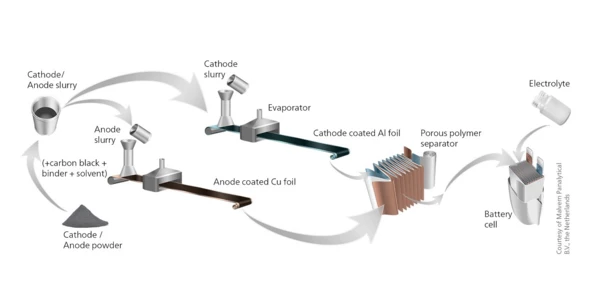
Solutions
The majority of cathode active materials are in the electrode with limited electrical conductivity. Additionally the polymer matrix in the electrode needs to be electrical conductive. That is why additives are used also to reduce the required charging time of the battery when being added to the battery slurries. Here it is primarily the carbon-based raw materials that are used, such as carbon black, graphite and carbon nano tubes (CNTs), which should be characterized by the highest possible aspect ratio. The materials must first be carefully dispersed in preliminary stages. Here the size of the primary particles, the properties of the bulk solids and the purity requirements usually present particular challenges, which we can solve with disperser such as Epsilon, Omega®.
De-Bundling of MWCNTs as Conductive Slurry
Theoretically CNTs with large aspect ratios are more effective to form a continuous and conductive network throughout the composite and to gain a much lower percolation threshold. However, practically it is impossible to de-bundle the CNTs having a large aspect ratios to use CNTs as a conductive slurry due to extremely high viscosity leading to high viscosity of the final electrode slurry.
To choose the right machine to de-bundle the CNTs, firstly have to check the type of CNTs properties like as diameter, length, type. Depending on the type of CNTs, you can choose some options.

Pumping system is important in battery producing lines, which has been used to convey many kinds of glue and battery slurry and so on mediums, as the dosing and metering pumps, mainly application in the battery slurry process and coating procedure. And volume of slurry applied to the coating depends on flow rate.
In the coating process, progressing cavity pump (e.g. NEMO® pump) is suitable because of its dosing character. A variety of primary raw materials are pumped to the stirring tank and after being stirred at a high speed. So High-viscosity and high-concentration slurries can be continuously supplied without pulsation to a coater, providing a thin and even film thickness. Because pumping system conveys medium with low pulsation, requirement of coating process in battery manufacturing can be satisfied.
Application of pumping system
Lithium slurry is one of the most demanding media to be conveyed. Lithium does not occur freely in nature due to its high reactivity. It is only stable in a complete dry environment but slowly reacts to lithium nitride. A matt gray lithium hydroxide layer quickly forms on the surface in moist air. Elemental lithium already reacts in contact with the skin's moisture and thus leads to heavy burns.
In this case, progressing cavity pump in stainless steel with flexible rod from NETZSCH can be chosen. The main characteristic of this pump type is the eccentric screw principle in which a spiral rotor rotates oscillating in a geometrically matched stator. This results in uniform delivery chambers in which the medium is moved continuously from the suction to the pressure side free of pressure fluctuations, pulsation or shear forces.
In order to meet the high requirements of the reaction sensitive light metal a flexible rod connects the drive with the shaft instead of open or oil filled joints. The shaft has a shrink with the rotor and the connection to the drive shaft, so that both interfaces are hermetically sealed. Since no components rub against each other at the connections, the flexible rod hardly wears out and requires neither sealing nor lubrication. The maintenance-free flexible rod causes hardly any maintenance costs. For this reason a PTFE sleeve seal without oil is also used as the mechanical seal. Stainless steel and a NEMOLAST® stator were used as materials for the battery manufacturer's application.
The polished stainless steel surfaces ensure that the medium cannot adhere. This reduces contamination to a minimum and makes the pump easy to clean, which is an important requirement in a chemical process. To take account of the highly explosive mixture of the medium, the pumps are driven by an electric motor. As a result, this process improves battery quality.
Operating Principle
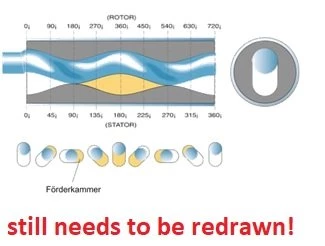
The axial speed is very small that means low shear rate is applied into the medium, so the results is that the mechanical and chemical characteristics of the medium doesn’t change conserves its viscosity without break any emulsion.
Pumping system keeps the same volumetric displacement each rotation, the flux volume can be based on the volumetric displacement.
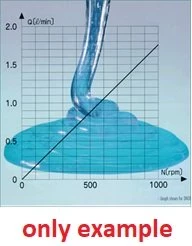
There are some advantages for conveying medium with pumping system.
- keep linear performance with the rotating speed, the same volumetric displacement each rotation, work well as a dosing and metering pump
- no pulsation, continuous uninterrupted flow
- Shear sensitive Mediums, low shear factor of all type of pumps, can handly solids particles without damage them, with High solid, high viscosity.
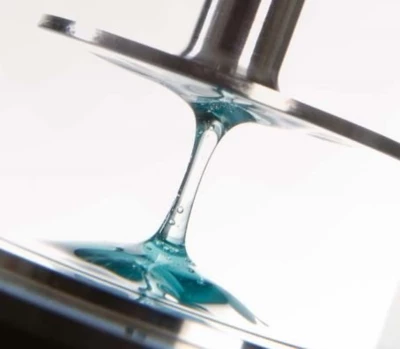
Rheology provides access to these flow properties of battery slurries. Different low-shear behavior can influence the leveling. With high solid content, shear thickening might occur in processing shear rate range and causes difficulties during the coating process. In addition to the shear viscosity function, the elasticity of the slurry under shear flow is important. It can lead to flow instabilities, such as film rupture or uneven edges of the coating layer. Elasticity of the slurry, however, helps prevent sedimentation of the particles at rest and needs to be balanced against the negative impact of elastic normal stresses on the processing.
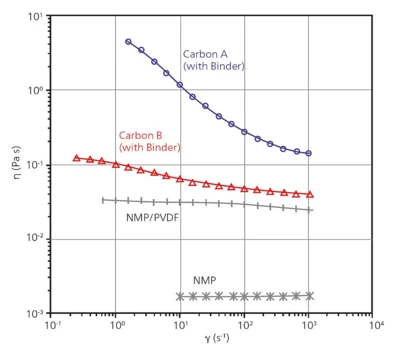
The graph on the right shows the viscosity measurement results of slurry mixed with NMP/PVDF/Carbon black/Binder.
NMP and NMP/PVDF are in the state of Newtonian behavior, and mixing carbon black with them changes rheological properties into fluids showing Non-Newtonian behavior. Carbon A maintains higher viscosity in all shear rate ranges than slurry mixed with Carbon B. This means that Carbon A has increased resistance to sedimentation in low shear processes. On the contrary, since the viscosity of carbon B is lower in a high shear process, it may be predicted that a coating layer may be formed thinner than a carbon A slurry.